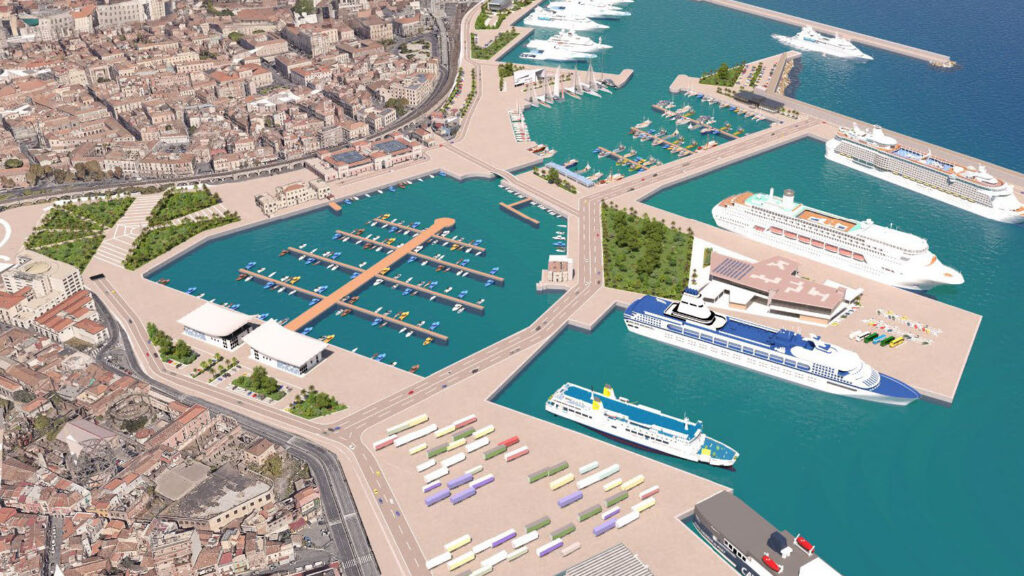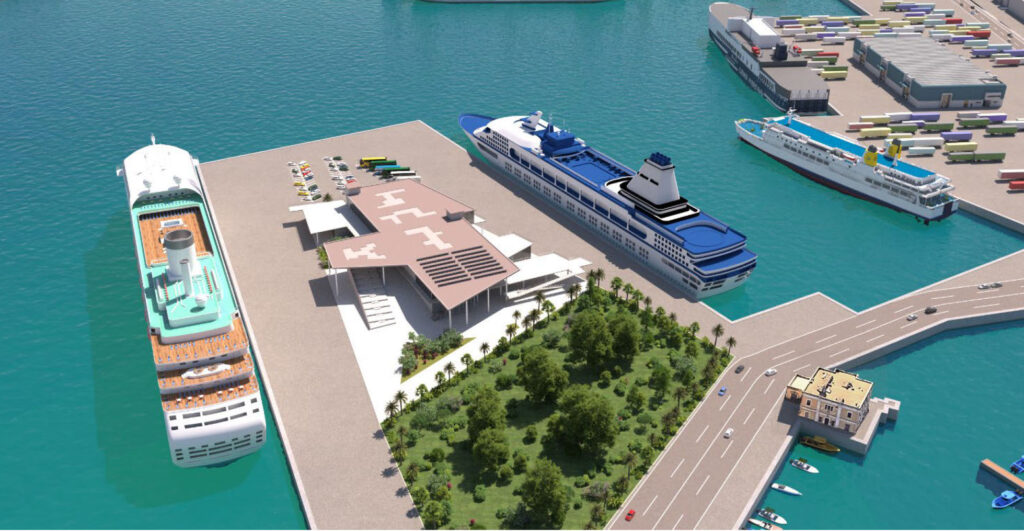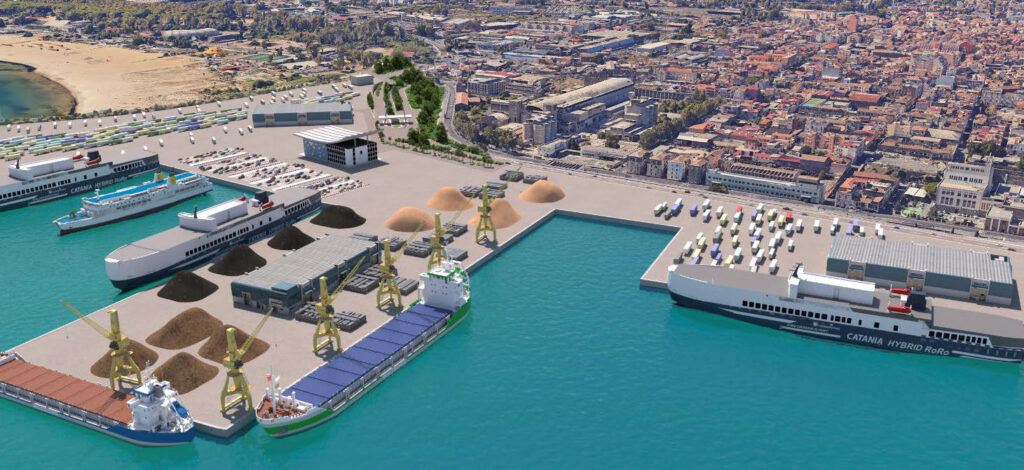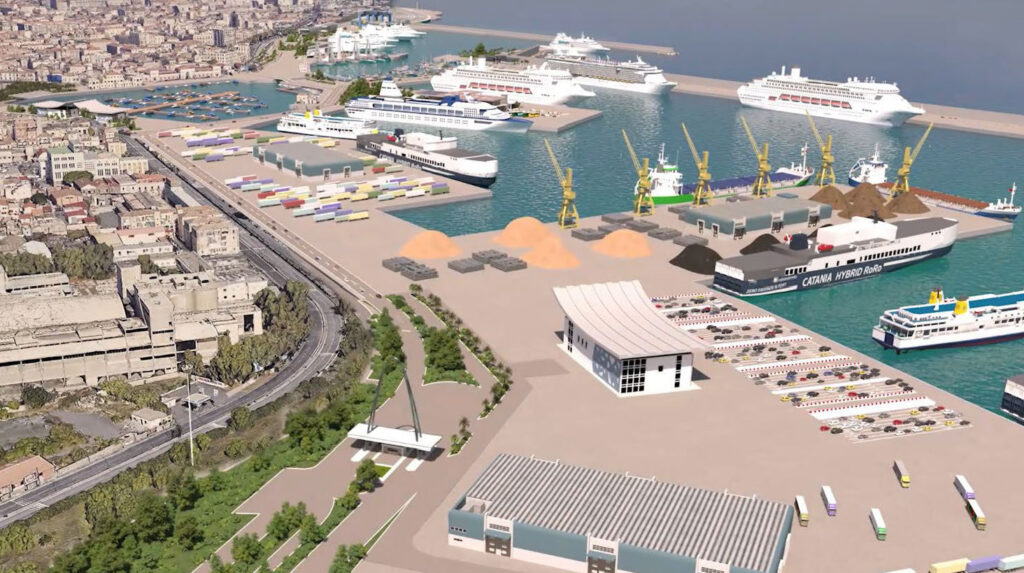╔
Dal porto alla città: prospettive per un nuovo dialogo
Da circa un ventennio, ormai, gli scali portuali sono al centro di un processo osmotico di trasformazione e conversione che permea il territorio urbano, dalle banchine d’ormeggio sino a radicarsi nel profondo dei centri storici, strutturando e caratterizzando lo spazio di dialogo fra porto e città.
Le città “storicamente” portuali, con una vision aperta e votata al rinnovamento, hanno compreso la necessità di aderire ad una nuova visione del ruolo delle infrastrutture nel processo di sostegno all’economia delle comunità. Si è, così, riscritto il contributo che un porto è potenzialmente in grado di fornire in quel contesto, prima solo come semplice gate d’accesso delle merci nei territori, poi come fulcro di processi, a volte fisici ma spesso intangibili, che hanno dato vita a quartieri urbani, aree di waterfront, zone economiche speciali d’investimento e spazi di trasformazione industriale.
Catania si trova impegnata in questo processo, avviato quasi inconsciamente per rispondere ad una necessità di sfogo che oggi è divenuta pregna di consapevolezza, alle soglie di un nuovo step, con l’impellente e irrinunciabile obbligo di non lasciarsi sfuggire, ancora una volta, l’opportunità di partecipare attivamente al cambiamento.
Circa un anno fa l’Autorità di Sistema Portuale del Mare di Sicilia Orientale, che annovera gli scali di Augusta, Catania, Pozzallo, cui fra non molto è previsto l’inserimento di Siracusa, ha avviato l’iter per la predisposizione del nuovo Piano Regolatore Portuale di Catania, lavorando, da una parte, alla declinazione delle scelte strategiche dettate in sede di Documento di Programmazione Strategica di Sistema, dall’altra alla composizione del quadro di fattibilità delineato dagli studi specialistici di settore.
Il risultato è un documento di pianificazione imbasato su alcuni obiettivi prioritari: sviluppo della vocazione turistica e passeggeri del porto di Catania, individuazione di un modello sostenibile e rispettoso dell’ambiente, avvio di un nuovo dialogo fra porto e città, adeguamento delle infrastrutture ai moderni standard delle navi, separazione e razionalizzazione delle funzioni. Quest’ultimo rappresenta il cardine di una svolta positiva con un fine ambivalente, da un lato consentire alla città di vivere il porto come una promanazione urbana, dall’altro ottimizzare e rendere più sicuro il ciclo produttivo portuale.
Gli studi di settore che corredano il nuovo PRP sono stati commissionati e predisposti da soggetti altamente qualificati nell’ambito di tre tematiche principali: ambiente, sicurezza e sviluppo socioeconomico.
Lo stato attuale rileva un’infrastruttura portuale dedita in primis al comparto turistico con un consolidato traffico crociere e traghetti (Ro-Ro), con alcuni insediamenti diportistici e pescherecci e piccoli cantieri navali dedicati, a latere una realtà storica legata al traffico general cargo che, seppur con statistiche altalenanti, mantiene una presenza costante a servizio dell’area industriale Etnea. Il traffico container, che negli ultimi quindici anni ha rappresentato un insediamento in crescita sino a costituire il principale terminal siciliano, è stato il primo reale passo verso l’integrazione richiesta ad un sistema portuale, trasferendosi dal congestionato porto di Catania agli spazi ampiamente più promettenti di Augusta.
Una delle sfide che subito si sono poste innanzi agli Uffici della Direzione Infrastrutture e Pianificazione dell’Autorità di Sistema Portuale del Mare di Sicilia Orientale, che ha curato direttamente la redazione del piano, è stata spezzare l’atavica commistione fra la parte commerciale e quella “urbana” del porto, garantendo alle originarie funzioni i margini necessari ad una cauta quanto realistica crescita, senza per ciò dover disporre di ampliamenti dell’ambito portuale verso sud, dove inizia la Playa turistica. La soluzione a questa mixture di criticità ha, di fatto, caratterizzato l’intero processo di nascita del layout portuale. Da qui l’idea di separare fisicamente i flussi di accesso/uscita dal porto del naviglio maggiore da quelli turistici, con la realizzazione di una nuova diga di sopraflutto radicata sotto la falesia su cui campeggia la stazione centrale, cui seguirà l’apertura di due connessioni ricavate dalla demolizione di un primo tratto del molo foraneo esistente e della radice del Molo Sporgente Centrale. Una volta costruiti anche l’attraversamento in corrispondenza del molo F. Crispi e la congiunzione fra i due pennelli di levante, si delineerà la piena separazione fra la zona sud dello scalo, destinata alla parte commerciale, e il waterfront ospitato dai tre bacini così originati: il porto vecchio, il porto nuovo e quello turistico, in cui potranno trovare posto, in ordine rispettivamente crescente, le imbarcazioni da diporto e da pesca dalle più piccole sino alle più grandi, per giungere, in corrispondenza del bacino esterno, al ricovero per maxi yacht sino a 120 m. di lunghezza. Il comparto delle luxury cruise e delle grandi imbarcazioni private è in costante e frenetica crescita, soprattutto in quei terminali portuali del Mediterraneo facilmente raggiungibili in aereo e che offrono target turistici di fama internazionale (Etna, Taormina …). Nell’area di waterfront, di oltre 17 ettari, convivranno spontaneamente gli immancabili insediamenti che costituiscono ormai da anni l’anima del dialogo fra porto e città: ristoranti, aree a verde, parcheggi e zone ricreative, con gli affascinanti servizi le club house, i servizi e la cantieristica.
For about twenty years now, ports have been at the center of an osmotic process of transformation and conversion that permeates the urban territory, from the mooring docks to the depths of the historic centers, structuring and characterizing the space of dialogue between port and city.
“Historically” port cities, with an open vision devoted to renewal, have understood the need to adhere to a new vision of the role of infrastructure in the process of supporting the economy of communities. Thus, the contribution that a port is potentially able to provide in that context has been rewritten, first only as a simple gate of access for goods in the territories, then as the fulcrum of processes, sometimes physical but often intangible, which have given rise to urban neighborhoods, waterfront areas, special economic investment zones and spaces for industrial transformation.
Catania is engaged in this process, started almost unconsciously to respond to a need for venting that today has become full of awareness, on the threshold of a new step, with the urgent and indispensable obligation not to let slip, once again, the opportunity to actively participate in change.
About a year ago, the Port System Authority of the Eastern Sicilian Sea, which includes the ports of Augusta, Catania, Pozzallo, which is expected to be included in Syracuse shortly, started the process for the preparation of the new Port Regulatory Plan of Catania, working, on the one hand, on the declination of the strategic choices dictated in the Strategic System Planning Document, on the other hand, the composition of the feasibility framework outlined by the sector’s specialist studies.
The result is a planning document based on a number of priority objectives: development of the tourist and passenger vocation of the port of Catania, identification of a sustainable and environmentally friendly model, start of a new dialogue between port and city, adaptation of infrastructures to modern ship standards, separation and rationalization of functions. The latter represents the cornerstone of a positive turning point with an ambivalent purpose, on the one hand to allow the city to experience the port as an urban emanation, and on the other to optimize and make the port production cycle safer.
The sector studies that accompany the new PRP have been commissioned and prepared by highly qualified individuals in the context of three main themes: environment, safety and socio-economic development.
The current state reveals a port infrastructure dedicated primarily to the tourism sector with a consolidated cruise and ferry traffic (Ro-Ro), with some pleasure boat and fishing boat settlements and small dedicated shipyards, on the side of a historical reality linked to general cargo traffic which, albeit with fluctuating statistics, maintains a constant presence at the service of the Etna industrial area. Container traffic, which in the last fifteen years has represented a growing settlement to constitute the main Sicilian terminal, was the first real step towards the integration required of a port system, moving from the congested port of Catania to the largely more promising spaces of Augusta.
One of the challenges that immediately faced the Offices of the Infrastructure and Planning Directorate of the Port System Authority of the Eastern Sicilian Sea, which directly oversaw the drafting of the plan, was to break the atavistic mixture between the commercial and the “urban” part of the port, guaranteeing the original functions the necessary margins for a cautious and realistic growth, without having to have to expand the port area to the south, where the tourist beach begins. The solution to this mixture of critical issues has, in fact, characterized the entire process of the birth of the port layout. Hence the idea of physically separating the access/exit flows from the port of the Naviglio Maggiore from the tourist ones, with the construction of a new breakwater rooted under the cliff on which the central station stands, which will be followed by the opening of two connections obtained from the demolition of a first section of the existing breakwater and the root of the Central Protruding Pier. Once the crossing at the F. Crispi pier and the junction between the two eastern brushes have been built, the full separation between the southern area of the port, intended for the commercial part, and the waterfront hosted by the three basins originated as follows: the old port, the new port and the tourist port, in which they will be able to find space. In ascending order, respectively, pleasure and fishing boats from the smallest to the largest, to reach, in correspondence with the external basin, the shelter for maxi yachts up to 120 m. in length. The luxury cruise and large private boats sector is constantly and frenetically growing, especially in those port terminals of the Mediterranean that are easily accessible by plane and that offer internationally renowned tourist targets (Etna, Taormina …). In the waterfront area, of over 17 hectares, the inevitable settlements that have been the soul of the dialogue between the port and the city for years will spontaneously coexist: restaurants, green areas, parking lots and recreational areas, with the fascinating services of the clubhouse, services and shipbuilding.

Vista aerea della nuova area diportistica e del terminal crociere. (Fonte: Autorità di Sistema Portuale del Mare di Sicilia Orientale).
Aerial view of the new yachting area and the cruise terminal. (Source: Port System Authority of the Eastern Sicilian Sea).
Al centro del nuovo disegno portuale sorge la stazione marittima, opera che parla alla città con uno spiccato linguaggio architettonico. Cinquemila metri quadri involti da vetro e acciaio, alternati da piani orizzontali svettanti verso il mare, che danno la sensazione di un manufatto adagiato sui piazzali dello sporgente centrale, integrato nella morfologia esistente con inserti di verde e allestimenti ecosostenibili, pronto ad ospitare sino a un milione di passeggeri l’anno in presenza delle navi da crociera ed eventi culturali aperti alla fruizione cittadina nel restante tempo.
At the center of the new port design stands the maritime station, a work that speaks to the city with a strong architectural language. Five thousand square meters surrounded by glass and steel, alternating with horizontal planes soaring towards the sea, which give the feeling of a building lying on the squares of the central projection, integrated into the existing morphology with green inserts and eco-sustainable fittings, ready to accommodate up to a million passengers a year in the presence of cruise ships and cultural events open to city use in the remaining time.

Nuova stazione marittima per le crociere. (Fonte: Autorità di Sistema Portuale del Mare di Sicilia Orientale).
New cruise maritime terminal. (Source: Port System Authority of the Eastern Sicilian Sea).
Per consentire la creazione di questo straordinario insediamento urbano, all’interno del porto, senza condizionare l’operatività e la crescita della parte commerciale dello scalo etneo, che è e rimane un porto di primaria importanza nella movimentazione merci (soprattutto rotabili) in Italia, il progetto prevede la razionalizzazione delle aree e delle funzioni della zona sud. L’obiettivo più sfidante è rimasto quello di ridisegnare il layout e i confini fra la parte urbana e quella merci del porto, senza “traghettare” l’ambito strictu sensu commerciale al di là del confine del torrente Acquicella e senza invadere il contesto urbanizzato con insediamenti retroportuali.
In order to allow the creation of this extraordinary urban settlement, within the port, without affecting the operation and growth of the commercial part of the Etna port, which is and remains a port of primary importance in the handling of goods (especially rolling stock) in Italy, the project provides for the rationalization of the areas and functions of the southern area. The most challenging objective remained that of redesigning the layout and boundaries between the urban and freight parts of the port, without “ferrying” the commercial area beyond the boundary of the Acquicella stream and without invading the urbanized context with backport settlements.

Vista aerea dell’area commerciale. (Fonte: Autorità di Sistema Portuale del Mare di Sicilia Orientale).
Aerial view of the commercial area. (Source: Port System Authority of the Eastern Sicilian Sea).
Il riempimento di un bacino non più utilizzabile, il completamento verso il mare della zona a terra della darsena traghetti, la realizzazione di piccoli inserti sulle banchine esistenti, hanno condotto verso la soluzione per centrare il target prefissato e conseguire anche l’obiettivo di ridurre l’occupazione di suolo “pregiato” con l’impronta portuale. L’ambito commerciale avrà così uno sviluppo di 38 ettari, con la presenza di undici accosti dedicati al traffico traghetti e, in parte residuale, al general cargo. Tale fabbisogno infrastrutturale sarebbe in grado di condurre la crescita del traffico operato negli ultimi quindici anni dallo scalo etneo sino al 2040, offrendo spazi, ormeggi e magazzini, utili a sostenere il ruolo di principale terminal commerciale del sud italia.
The filling of a basin that is no longer usable, the completion of the land area of the ferry dock towards the sea, the construction of small inserts on the existing quays, have led to the solution to achieve the set target and also achieve the goal of reducing the occupation of “valuable” land with the port footprint. The commercial area will thus have a development of 38 hectares, with the presence of eleven berths dedicated to ferry traffic and, in residual part, to general cargo. This infrastructural need would be able to lead the growth of traffic operated in the last fifteen years from the Etna airport until 2040, offering spaces, moorings and warehouses, useful to support the role of main commercial terminal in southern Italy.

L’area del waterfront dove convivranno gli insediamenti urbani e portuali. (Fonte: Autorità di Sistema Portuale del Mare di Sicilia Orientale).
Aerial view of the commercial area and new waterfront. (Source: Port System Authority of the Eastern Sicilian Sea).
Altri due importanti progetti sostengono il manifesto su cui campeggiano i principi di sostenibilità e permeabilità cui si ispira questo nuovo progetto di piano regolatore portuale: la fascia filtro con il tessuto urbano e l’accesso interrato al porto. Quest’ultimo è un intervento destinato a risolvere definitivamente la criticità generata dalla coesistenza, sulla medesima sede stradale, del traffico portuale in ingresso/uscita dallo scalo etneo e di quello da e verso la città. Uno studio di fattibilità condotto su incarico dell’AdSP ha, infatti, dimostrato la sussistenza di una soluzione percorribile per interrare la via di collegamento fra l’Asse dei Servizi (bretella che connette l’ingresso sud di Catania con la tangenziale che conduce al network delle principali autostrade regionali) e il varco portuale. Ciò separerebbe i flussi di traffico pesante diretti o provenienti dal porto da quelli cittadini che, soprattutto in estate, affollano un punto nevralgico di connessione con la fascia turistica della Playa.
Il dialogo da riconquistare con la città passa anche attraverso una “decompressione” graduale del peso delle attività portuali, a nord grazie al già accennato waterfront, che lungo il confine Est sarà rimodellato in una fascia filtro di circa dieci metri, in cui pensare ad interventi di gemellaggio con la città, che si conclude a sud con un importante progetto di riqualificazione tramite un trattamento di fitodepurazione e rinaturalizzazione della foce del torrente Acquicella, da realizzare su un’area di circa 70 mila metri quadri. L’essenza del progetto è di avviare, attraverso il risanamento di una zona oggi particolarmente degradata anche sotto il profilo ambientale, il percorso sostenibile e paesaggistico che l’intero litorale della Playa sarebbe in grado di offrire a cittadini e turisti per decine di chilometri.
Two other important projects support the manifesto on which the principles of sustainability and permeability that inspire this new port master plan project stand out: the filter strip with the urban fabric and the underground access to the port. The latter is an intervention intended to definitively solve the criticality generated by the coexistence, on the same roadway, of port traffic entering/leaving the Etna port and that to and from the city. A feasibility study conducted on behalf of the Port Authority has, in fact, demonstrated the existence of a viable solution to bury the connection road between the Axis of Services (link road that connects the southern entrance of Catania with the ring road that leads to the network of the main regional highways) and the port gate. This would separate the flows of heavy traffic to or from the port from those of the city which, especially in summer, crowd a nerve center of connection with the tourist area of the Playa.
The dialogue to be regained with the city also passes through a gradual “decompression” of the weight of port activities, to the north thanks to the already mentioned waterfront, which along the eastern border will be remodeled into a filter strip of about ten meters, in which to think of twinning interventions with the city, which ends in the south with an important redevelopment project through a phytoremediation treatment and renaturalization of the mouth of the Acquicella stream, to be built on an area of about 70 thousand square meters. The essence of the project is to start, through the reclamation of an area that is now particularly degraded also from an environmental point of view, the sustainable and landscape path that the entire coastline of the Playa would be able to offer to citizens and tourists for tens of kilometers.
IMMAGINE INIZIALE | Riorganizzazione degli spazi e delle attività nel Porto di Catania. (Fonte: Autorità di Sistema Portuale del Mare di Sicilia Orientale).
HEAD IMAGE | Reorganization of spaces and activities in the Port of Catania. (Source: Port System Authority of the Eastern Sicilian Sea).